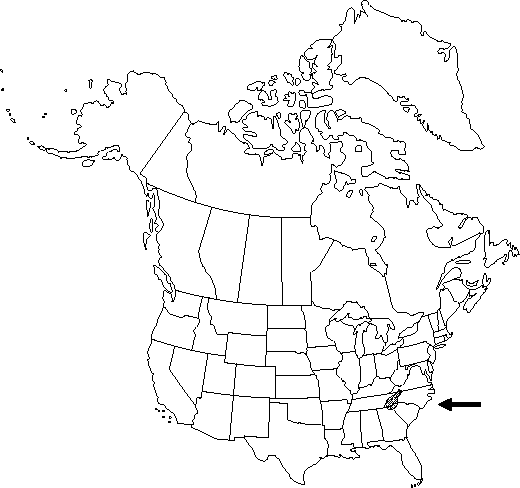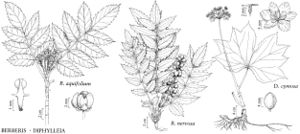Diphylleia cymosa
Fl. Bor.-Amer. 1: 203. 1803.
Leaves of nonflowering shoots 2.5-9 dm. Leaf-blades 13-53 cm diam. Flowering shoots 6-12 dm; leaves alternate, unequal in size; proximal leaf petioles 10-18 cm, blades 17-46 × 23-56 cm; distal leaf petioles 3-15 cm, blades 10-38 × 15-51 cm. Leaf-blade divided at apex and base into 2 parts, each part 5-9-lobed, lobes broadly acuminate, abaxially sparsely pubescent with unicellular hairs. Inflorescences cymose, glabrous; peduncle 0.2-4 cm; pedicel 0.7-3.5 cm; peduncle and pedicel turning red at fruit maturity. Flowers 7-70 (or more); outer sepals 1.7-4.5 × 0.4 mm; inner sepals 2.5-6 × 3.5-4 mm; outer petals narrowly obovate, 9-11 × 4.5-6 mm; inner petals elliptic to obovate, 10-13×6-7 mm; stamens 3-4 mm; filaments 1-2 mm; anthers 2 × 1 mm; ovaries ellipsoid, 3-5 × 1.5-2.5 mm; stigma 0.5-1 mm. Berries 6-13 × 4-11 mm. Seeds 2-4, 4-7 × 2-5 mm, abaxially rounded, adaxially flattened to concave. 2n = 12.
Phenology: Flowering late spring, fruiting summer.
Habitat: Forming dense colonies on moist slopes in mixed deciduous forests, in seepages, or along streams
Elevation: 800-1700 m
Distribution

Ga., N.C., S.C., Tenn., Va.
Discussion
Diphylleia cymosa is endemic to the Blue Ridge Mountains of the southern Appalachians. It is occasionally grown in woodland gardens.
Cherokee Indians are reported to have used D. cymosa to treat a variety of ailments and as a disinfectant (D. E. Moerman 1986).
Selected References
None.
Lower Taxa
"dm" is not declared as a valid unit of measurement for this property.
